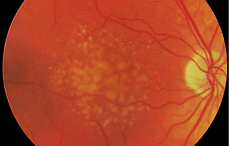Elevated levels of high-sensitivity C-reactive protein (hsCRP)—a common blood test—can predict future risk of age-related macular degeneration, according a new study published online in JAMA Ophthalmology.

Elevated levels of C-reactive protein indicate a higher risk for AMD.
The study’s research team, which included scientists from Harvard, Johns Hopkins University and the University of Utah, evaluated blood samples from approximately 2,000 participants from five previous cancer and heart disease studies.
The researchers found that people with high levels (more than 3mg/L) of hsCRP—a biomarker for inflammation related to heart disease, cancer and other conditions—have a 49% greater risk of all forms of AMD compared to people with low levels of hsCRP (less than 1mg/L). High levels of hsCRP were also associated with an 84% increased risk for wet AMD.
These findings “add further evidence that elevated levels of hsCRP predict greater future risk of AMD,” the authors concluded. “This information might shed light on underlying mechanisms and could be of clinical utility in the identification of persons at high risk of AMD who may benefit from increased adherence to lifestyle recommendations, eye examination schedules and therapeutic protocols.”
Mitta VP, Christen WG, Glynn RJ, et al. C-reactive protein and the incidence of macular degeneration: Pooled analysis of 5 cohorts. JAMA Ophthalmol. 2013 Feb 7:1-7. [Epub ahead of print]

